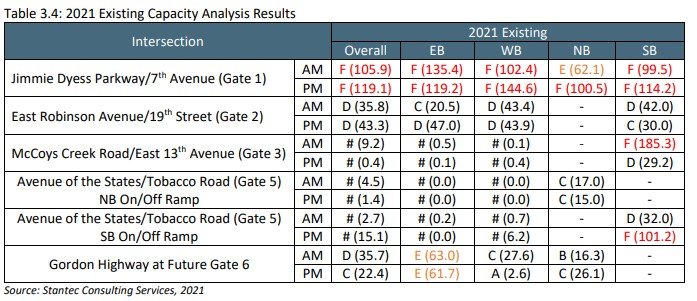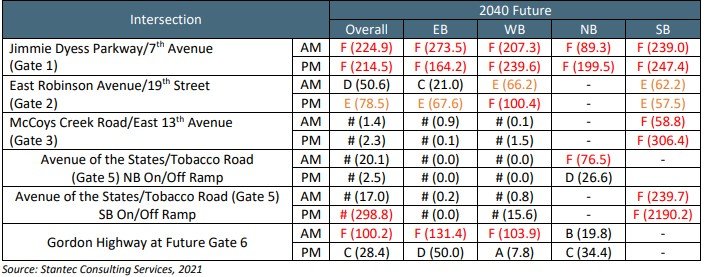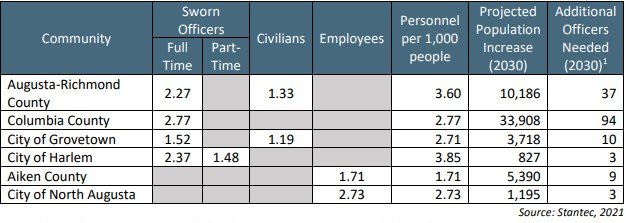The CSRA Regional Commission has undertaken a project to gauge the population growth connected with Fort Gordon and its impact on the Augusta-Aiken area.
The commission is working with Canada-based Stantec, Inc. to build the Fort Gordon Regional Management Plan. It will focus on the challenges associated with growth at the post in recent years and look at anticipated growth in the future.
The goals are to help local communities prepare and plan for the growth as well as ensure the quality of life for both civilian and military communities. Seven counties are in the study; Augusta-Richmond, Columbia, Burke, Lincoln and McDuffie Counties in Georgia; Aiken and Edgefield Counties in South Carolina.
The work began with an advisory group meeting in April 2021. The first three chapters of the study were released during a virtual public meeting on Oct. 19. The chapters looked at demographics and population projections, transportation and police and fire protection.
Research found Fort Gordon added about 9,000 service members between 2010 and 2019. Adding in family members, civilian contractors and associated support personnel brought the total population increase to more than 47,000 residents. Based on Department of Defense projections, it is anticipated there will be 2,000 more by the end of this year. Columbia County saw the highest number of new residents, followed then by Augusta-Richmond County and Aiken County.
[adrotate banner=”54″]
The population increases are having the expected impact on roads around the post, particularly Gordon Highway, Jimmie Dyess Parkway, Robinson Avenue and Tobacco Road. Currently, the highest delays are at Jimmie Dyess Parkway/Gate 1 and Tobacco Road/Gate 5, as illustrated in a chart created by Stantec. The red letters indicate the level of service during peak hours; E and F signify inadequate conditions. The numbers are the number of seconds of delay per vehicle.

Projecting traffic patterns to 2040 show how the expected continued population growth will exacerbate today’s problem spots and create delays at additional areas.

The study also lists improvement priorities in the near-term, such as constructing a third eastbound lane at Gordon Highway and Jimmy Dyess Parkway; mid-term, including a third westbound lane on Gordon Highway at Gate 6 and long-term, which could include a partial cloverleaf at Gordon Highway and Jimmie Dyess Parkway.
Turning its attention to public safety, including police, fire and EMS services, the study analyzed current resources and looked at future needs.
The report says, currently, Augusta-Richmond County has 19 fire stations with more 300 firefighters who are cross-trained as emergency medical technicians. As of 2017, the county’s rating from the Insurance Services Office was one, which is the best rating a fire department can receive. The county is served by six ambulance companies.
In unincorporated Columbia County, there are 17 engine companies; 15 are staffed 24 hours a day. The remaining two stations are fully equipped but unstaffed and are covered by volunteers. Total staffing is 170 career and volunteer firefighters. The county ISO rating is also one, the highest possible.
In addition to the county fire stations, the incorporated cities of Grovetown and Harlem have fire protection from their city departments. Both cities and the county participate in a mutual aid agreement. Ambulance service in the county is provided by Gold Cross Ambulance which has four locations within the county.
Much of Aiken County is covered by volunteer fire departments, although the City of Aiken and North Augusta both have their own fire departments. In all, the report found there are 43 fire stations across the county. There are multiple ISO ratings in Aiken County ranging from two to nine. The City of Aiken’s ISO rating is two; North Augusta’s is three. Aiken County is serviced by six ambulance services.
Looking ahead the report notes:
“The need for additional fire personnel is directly related to the location of new development. Since service criteria are based upon response times, new construction that occurs in already developed areas that are close to existing services will create less of a need for additional fire stations. The majority of fire stations within the Study Area report issues with funding and staffing. It is important that city and county governments responsible for land use regulation coordinate with fire services to ensure that new construction can be served and does not create additional strain on the existing fire services.”
[adrotate banner=”51″]
Augusta-Richmond County is planning to build one new station near Gate 1. Columbia County has plans for two new stations within the next four years, one at Washington Road and Rosemont Drive area, the other at Highway 150 and Smith Crawford Road. Aiken County wants to take several steps, including instituting a minimum qualification program for all firefighters and investigating the feasibility of district consolidation on an incremental basis.
Finally, the study looked at existing law enforcement resources and future needs.
The report says unincorporated Augusta-Richmond County, excluding Hephzibah and Blythe, is protected by the sheriff’s office, with 449 full-time sworn deputies and 263 full-time civilians.
Unincorporated areas of Columbia County, excluding Grovetown and Harlem, are protected by 383 sworn deputies. Grovetown has 23 full-time sworn officers; Harlem has eight full-time and five part-time officers.
Unincorporated Aiken County, excluding the City of Aiken and North Augusta, is covered by the sheriff’s office. As of 2019, it reported 184 deputies. North Augusta reported 65 officers in 2020. The report did not include figures for the City of Aiken police department.
The analysis projected out to 2030 to determine likely needs to add law enforcement personnel. With the largest projected future population growth, Columbia County could need 94 more deputies. That’s followed by 37 for Augusta-Richmond County and 10 for Grovetown.

The study will present a total of nine chapters, including education, employment, economic development, housing, health care and childcare services in future virtual presentations. The next one is anticipated some time in November.
In the meantime, the reports are available for review and comment on the project website.
Members of the public unable to participate can watch a recording of the virtual public meeting which will be posted to the project site.
Comments can also be submitted through the project public input form or by email to cpappis@csrarc.ga.gov
Dana Lynn McIntyre is a Staff Reporter with The Augusta Press. You can reach her at dana@theaugustapress.com












